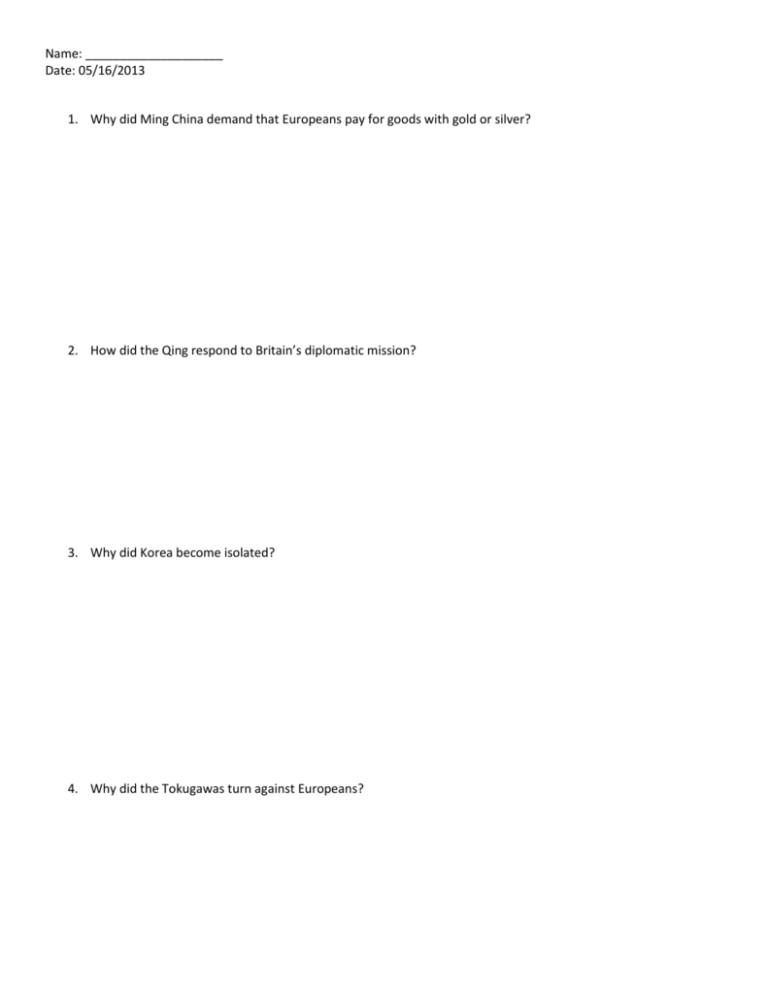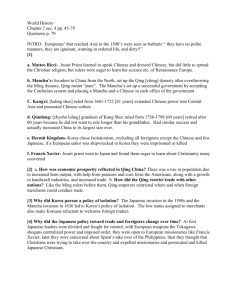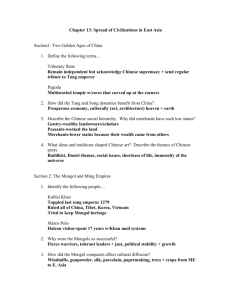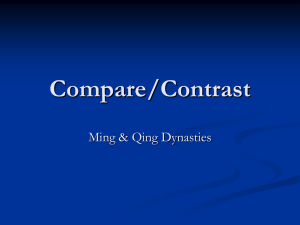File
advertisement

Name: ____________________ Date: 05/16/2013 1. Why did Ming China demand that Europeans pay for goods with gold or silver? 2. How did the Qing respond to Britain’s diplomatic mission? 3. Why did Korea become isolated? 4. Why did the Tokugawas turn against Europeans? Encounters in East Asia Informational Text Portuguese ships first reached China from their base in Malacca in 1514. To the Chinese, the Portuguese, like other foreigners, were barbarians. Europeans, by contrast, wrote enthusiastically about China. In 1590, a visitor described Chinese artisans “cleverly making devices out of gold, silver, and other metals,” and wrote with approval: “They daily publish huge multitudes of books.” 1. European Contact with Ming China European interest in china and other parts of East Asia continued to grow. The Ming, however, had no interest in Europe – since, as a Ming document proclaimed, “our empire owns the world.” The Ming Limit Trade The Portuguese wanted Chinese silks and porcelains, but had little to offer in exchange. European textiles and metalwork were inferior to Chinese products. The Chinese therefore demanded payment in gold and silver. The Ming eventually allowed the Portuguese a trading post at Macao near Canton, present-day Guangzhou. Later, they let Dutch, English, and other European trade with Chinese merchants. Foreigners could trade only at Canton under the supervision of imperial officials. When each year’s trading season ended, they had to sail away. Seeking Converts Portuguese missionaries arrived in China along with the traders. In later years the Jesuits – from Spain, Italy and Portugal – arrived. Most Jesuits had a broad knowledge of many subjects, and the Chinese welcomed the chance to learn about Renaissance Europe from these scholars. The brilliant Jesuit priest Matteo Ricci made a particularly strong impression on the Chinese. Still, Ricci and other priests had little success spreading their religious beliefs in China. They did, however, become important sources of information or Europeans who knew little about China. 2. The Manchu Conquest By the early 1600s, the aging Ming dynasty was decaying. Revolts erupted, and Manchu invaders from the north pushed through the Great Wall. The Manchus ruled a region in the northeast, Manchuria, that had long been influenced by Chinese civilization. In 1644, victorious Manchu armies seized Beijing and made it their capital. Founding the Qing Dynasty The Manchus set up a new dynasty called the Qing. The Manchus won the support of Chinese scholar officials because they adopted the Confucian system of government. For each top government position, the Qing chose two people, one Manchu and one Chinese. Local government remained in the hands of the Chinese, but Manchu troops stationed across the empire ensured loyalty. Two rulers oversaw the most brilliant age of the Qing. Kangxi, who ruled from 1661-1722, was an able administrator and military leader. He extended Chinese power into Central Asia and promoted Chinese culture. Kangxi’s grandson Qianlong had an equally successful reign from 1736-1796. He expanded China’s borders to rule the largest area in the nation’s history. Qianlong retired after 60 years because he did not want to rule longer than his grandfather had. Spreading Peace and Prosperity The Chinese economy expanded under both emperors. New crops from the Americas, such as potatoes and corn, had been introduced into China. These crops boosted farm output, which in turn contributed to a population boom. China’s population rose from 140 million in 1740 to over 300 million by 1800. The silk, cotton, and porcelain industries expanded. Internal trade grew, as did the demand for Chinese goods from all over the world. Rejecting Contact with Europeans The Qing maintained the Ming policy of restricting foreign traders. Still, Europeans kept pressing to expand trade to cities other than Guangzhou. In 1793, Lord Macartney arrived in China at the head of a British Diplomatic Mission. He brought samples of British-made goods to show the Chinese the advantages of trade with Westerners. The Chinese, who looked on the goods as rather crude products, through they were gifts offered as tribute to the emperor. Further misunderstandings followed. Macartney insisted on an audience with the emperor. The Chinese told Macartney he would have to perform the traditional kowtow, touching his head to the ground to show respect to the emperor. Macartney refused. He also offended the Chinese by speaking of the natural superiority of the English. The negotiations faltered. At the time, Qianlong’s attitude seemed justified by China’s successes. After all, he already ruled the world’s greatest empire. Why should he negotiate with a nation as distant as Britain? In the long run, however, his policy proved disastrous. In the 1800s, China would learn that its policy of ignoring Westerners and their technology would have undesired consequences. 3. Korea Chooses Isolation Before the 1500s, Korean traders had far-reaching contracts across East Asia. A Korean map from the 1300s accurately outlines lands from Japan to the Mediterranean. Koreans probably acquired this knowledge from Arab traders who came to Korea. In 1592, and again in 1597, the Japanese invaded Korea. The Japanese were driven out in 1598, but the invasions proved disastrous for Korea. Villages were burned to the ground, famine and disease became widespread, and the population decreased. Then, in 1636, before the country was fully recovered, the Manchus invaded Korea. When Manchus set up the Qing dynasty in China, Korea became a tributary state. It was run by its own government but forced to acknowledge China’s supremacy. Devastated by the two invasions, Korean rulers adopted a policy of isolation, excluding foreigners except the Chinese and a few Japanese. When European sailors were shipwrecked on Korean shores, they were imprisoned and held as spires. Although Korea, had few contacts with much of the world, for almost 250 years, Koreans on tribute missions brought back maps as well as books on scientific discoveries. This was also a great age for Korean arts and literature. 4. Foreign Traders in Japan Unlike the Chinese or Koreans, the Japanese at first welcomed Westerners. In 1543, the Portuguese reached Japan, followed by the Spanish, Dutch, and English. They arrived at a turbulent time, when Japanese daimyo were struggling for power. The daimyo quickly adopted Western firearms which may have helped the Tokugawa shoguns centralize power and impose order. Jesuits, such as the Spanish priest Francis Xavier, found the Japanese curious about Christianity. A growing number of Japanese adopted the new faith. The Japanese also welcomed the printing press the Jesuits brought. The Tokugawa shoguns, however, grew increasingly hostile toward foreigners. After learning that Spain had seized the Philippines, they may have seen the newcomers as threats. They also worried that Japanese Christians, who may have numbered many as 300,000- owed their allegiance to the pope, rather than the Japanese leaders. In response, the Tokugawas expelled foreign missionaries. They brutally persecuted Christians, killing many thousands of people. In 1638, the Tokugawas had turned against European traders as well. Japan barred all European merchants and forbade Japanese travel abroad. To further their isolation, they outlawed the building of large ships, thereby ending foreign trade. In order to keep informed about world events, they permitted just one or two Dutch ships each year to trade at a small island in Nagasaki harbor. Japan remained isolated for more than 200 years. Art and literature flourished, and internal trade boomed. Cities grew in size and importance, and some merchant families gained wealth and status. By the early 1700s, Edo had a million inhabitants, more than either London or Paris.






